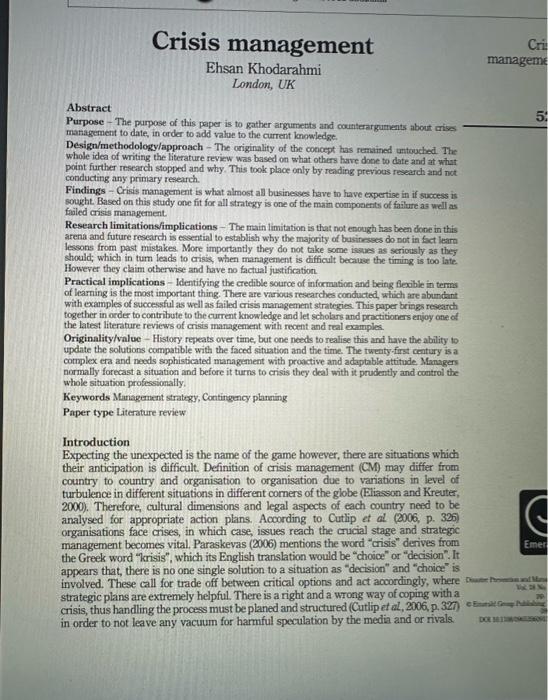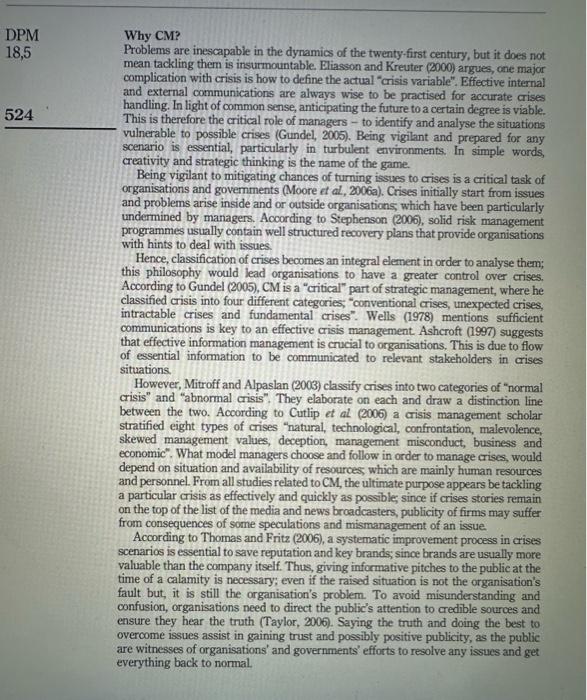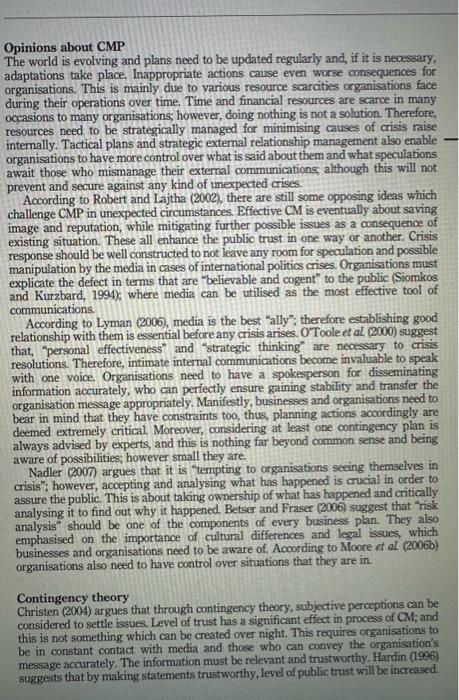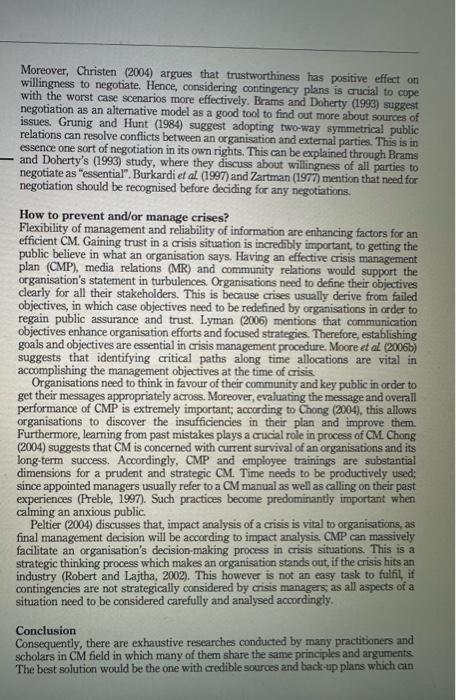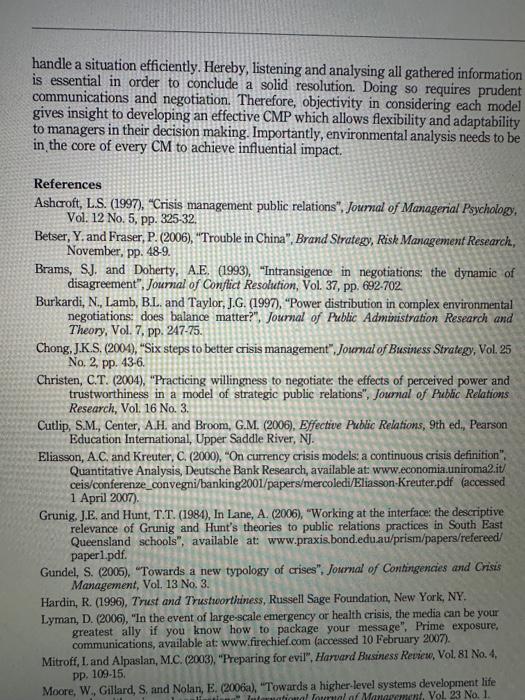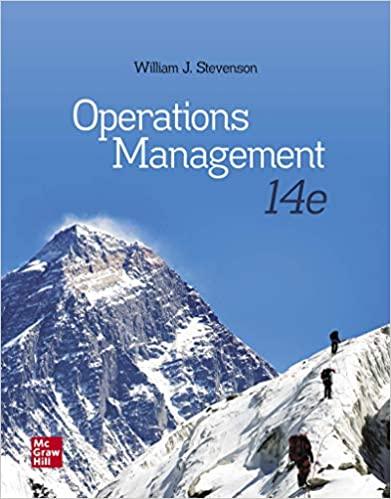- What was new or surprised you?
- What you agree or disagree?
Ehsan Khodarahmi London, UK Abstract Purpose - The purpose of this paper is to gather arguments and counterarguments about crises management to date, in order to add value to the current knowledge. Design/methodology/approach - The criginality of the conoept has remained untouched. The whole idea of writing the literature review was based on what others have done to date and at whe point further research stopped and why. This took place only by reading previous research and not. conducting any primary research. Findings - Crisis management is what almost all businesses have to have expertise in if success is sought. Based on this study one fit for all strategy is one of the main components of failure as well as failed crisis manngement. Research limitations/implications - The main limitation is that not enough has been done in this arena and future research is esseatial to establish why the majority of businesses do not in fot learm lessons from past mistakes. More importantly they do not take some issues as serionsly as they should; which in tum leads to crisis, when managernent is difficult because the timing is too lateHowever they claim otherwise and have no factual justification. Practical implications - ldentifying the credible souroe of information and being fexchle in terms of learning is the most important thing. There are various researches conducted, which are abundint with examples of successful as well as failed crisis manngement strategies. This paper brings research together in order to contribute to the current knowledge and let scholars and practitioners enjoy one of the latest literature reviews of crisis management with rooent and real examples Originality/value - History repeats over time, but one needs to realise this and have the ability to update the solutions compatible with the faced situation and the time. The twenty first century is a cotrolex era and needs sophisticated management with proactive and adaptable attitude Maragens normally forecast a situation and before it turns to crisis they deal with it prudently and control the whole situation professionally. Keywords Management strategy, Contingency planaing Paper type Literature review Introduction Expecting the unexpected is the name of the game however, there are situaticns which their anticipation is difficult. Definition of crisis management (CM) may differ from country to country and organisation to organisation due to variations in level of turbulence in different situations in different comers of the globe (Eliasson and Kreuter, 2000). Therefore, cultural dimensions and legal aspects of each country need to be analysed for appropriate action plans. Acoording to Cutlip et at (2006. p. 325) organisations face crises, in which case, issues reach the crucial stage and strategic management becomes vital. Paraskevas (2006) mentions the word "crisis" derives from the Greek word "krisis", which its English translation would be "choice" or "decision". It appears that, there is no one single solution to a situation as "decision" and "choice" is involved. These call for trade off between critical options and act accordingly, where onar strategic plans are extremely helpful. There is a right and a wrong way of coping with a crisis, thus handling the process must be planed and structured (Cutlip et al, 2006, p. 327) ef: in order to not leave any vacuum for harmful speculation by the media and or rivals. Why CM? Problems are inescapable in the dynamics of the twenty-first century, but it does not mean tackling them is insurmountable. Eliasson and Kreuter (2000) argues, one major complication with crisis is how to define the actual "crisis variable". Effective internal and external communications are always wise to be practised for accurate crises handling. In light of common sense, anticipating the future to a certain degree is viable. This is therefore the critical role of managers - to identify and analyse the situations vulnerable to possible crises (Gundel, 2005). Being vigilant and prepared for any scenario is essential, particularly in turbulent environments. In simple words, creativity and strategic thinking is the name of the game. Being vigilant to mitigating chances of turning issues to crises is a critical task of organisations and govemments (Moore ft al, 2006a). Crises initially start from issues and problems arise inside and or outside organisations, which have been particularly undermined by managers. According to Stephenson (2006), solid risk management programmes usually contain well structured recovery plans that provide organisations with hints to deal with issues. Hence, classification of crises becomes an integral element in order to analyse them; this philosophy would lead organisations to have a greater control over crises. According to Gundel (2005), CM is a "critical" part of strategic management, where he classified crisis into four different categories, "conventional crises, unexpected crises, intractable crises and fundamental crises". Wells (1978) mentions sufficient communications is key to an effective crisis management. Ashcroft (1997) suggests that effective information management is crucial to organisations. This is due to flow of essential information to be communicated to relevant stakeholders in crises situations. However, Mitroff and Alpaslan (2003) classify crises into two categories of "normal crisis" and "abnormal crisis". They elaborate on each and draw a distinction line between the two. According to Cutlip et at. (2006) a crisis management scholar stratified eight types of crises "natural, technological, confrontation, malevolence, skewed management values, deception, management misconduct, business and economic". What model managers choose and follow in order to manage crises, would depend on situation and availability of resources, which are mainly human resources and personnel. From all studies related to CM, the ultimate purpose appears be tackling a particular crisis as effectively and quickly as possible, since if crises stories remain on the top of the list of the media and news broadcasters, publicity of firms may suffer from consequences of some speculations and mismanagement of an issue. According to Thomas and Fritz (2006), a systematic improvement process in crises scenarios is essential to save reputation and key brands; since brands are usually more valuable than the company itself. Thus, giving informative pitches to the public at the time of a calamity is necessary; even if the raised situation is not the organisation's fault but, it is still the organisation's problem. To avoid misunderstanding and confusion, organisations need to direct the public's attention to credible sources and ensure they hear the truth (Taylor, 2006). Saying the truth and doing the best to overcome issues assist in gaining trust and possibly positive publicity, as the public are witnesses of organisations' and governments' efforts to resolve any issues and get everything back to normal. Opinions about CMP The world is evolving and plans need to be updated regularly and, if it is necessary, adaptations take place. Inappropriate actions cause even worse consequences for organisations. This is mainly due to various resource scarcities organisations face during their operations over time. Time and financial resources are scarce in many occasions to many organisations, however, doing nothing is not a solution. Therefore, resources need to be strategically managed for minimising catses of crisis raise internally. Tactical plans and strategic external relationship management also enable organisations to have more control over what is said about them and what speculations await those who mismanage their external communications, although this will not prevent and secure against any kind of unexpected crises. According to Robert and Lajtha (2002), there are still some opposing ideas which challenge CMP in unexpected circumstances. Effective CM is eventually about saving image and reputation, while mitigating further possible issues as a consequence of existing situation. These all enhance the public trust in one way or another. Crisis response should be well constructed to not leave any room for speculation and possible manipulation by the media in cases of international politics crises. Organisations must explicate the defect in terms that are "believable and cogent" to the public (Siomkos and Kurzbard, 1994); where media can be utilised as the most effective tool of communications. According to Lyman (2006), media is the best "ally"; therefore establishing good relationship with them is essential before any crisis arises. O'Toole et al (2000) suggest that, "personal effectiveness" and "strategic thinking" are necessary to crisis resolutions. Therefore, intimate internal communications become invaluable to speak with one voice. Organisations need to have a spokesperson for disseminating information accurately, who can perfectly ensure gaining stability and transfer the organisation message appropriately. Manifestly, businesses and organisations need to bear in mind that they have constraints too, thus, planning actions acoordingly are deemed extremely critical. Moreover, considering at least one contingency plan is always advised by experts, and this is nothing far beyond common sense and being aware of possibilities; however small they are. Nadler (2007) argues that it is "tempting to organisations secing themselves in crisis"; however, accepting and analysing what has happened is crucial in order to assure the public. This is about taking ownership of what has happened and critically analysing it to find out why it happened. Betser and Fraser (2006) suggest that "risk analysis" should be one of the components of every business plan. They also emphasised on the importance of cultural differences and legal issues, which businesses and organisations need to be aware of. According to Moore et at. (2006b) organisations also need to have control over situations that they are in. Contingency theory Christen (2004) argues that through contingency theory, subjective perceptions can be considered to settle issues. Level of trust has a significant effect in process of CM; and this is not something which can be created over night. This requires organisations to be in constant contact with media and those who can convey the organisation's message accurately. The information must be relevant and trustworthy. Hardin (1996) suggests that by making statements trustworthy, level of public trust will be increased Moreover, Christen (2004) argues that trustworthiness has positive effect on willingness to negotiate. Hence, considering contingency plans is crucial to cope with the worst case scenarios more effectively. Brams and Doherty (1993) suggest negotiation as an alternative model as a good tool to find out more about sources of issues. Grunig and Hunt (1984) suggest adopting two-way symmetrical public relations can resolve conflicts between an organisation and external parties. This is in essence one sort of negotiation in its own rights. This can be explained through Brams and Doherty's (1993) study, where they discuss about willingness of all parties to negotiate as "essential". Burkardi et al (1997) and Zartman (1977) mention that need for negotiation should be recognised before deciding for any negotiations. How to prevent and/or manage crises? Flexibility of management and reliability of information are enhancing factors for an efficient CM. Gaining trust in a crisis situation is incredibly important, to getting the public believe in what an organisation says. Having an effective crisis management plan (CMP), media relations (MR) and community relations would support the organisation's statement in turbulences. Organisations need to define their objectives clearly for all their stakeholders. This is because crises usually derive from failed objectives, in which case objectives need to be redefined by organisations in order to regain public assurance and trust. Lyman (2006) mentions that communication objectives enhance organisation efforts and focused strategies. Therefore, establishing goals and objectives are essential in crisis management procedure. Moore et al (2006b) suggests that identifying critical paths along time allocations are vital in accomplishing the management objectives at the time of crisis Organisations need to think in favour of their community and key public in order to get their messages appropriately across. Moreover, evaluating the message and overall performance of CMP is extremely important; acoording to Chong (2004), this allows organisations to discover the insufficiencies in their plan and improve them. Furthermore, learning from past mistakes plays a crucial role in process of CM Chong (2004) suggests that CM is concerned with current survival of an organisations and its long-term success. Accordingly, CMP and employee trainings are substantial dimensions for a prudent and strategic CM. Time needs to be productively used; since appointed managers usually refer to a CM manual as well as calling on their past experiences (Preble, 1997). Such practices become predominantly important when calming an anxious public. Peltier (2004) discusses that, impact analysis of a crisis is vital to organisations, as final management decision will be according to impact analysis. CMP can massively facilitate an organisation's decision-making process in crisis situations. This is a strategic thinking process which makes an organisation stands out, if the crisis hits an industry (Robert and Lajtha, 2002). This however is not an easy task to fulfil, if contingencies are not strategically considered by crisis managers, as all aspects of a situation need to be considered carefully and analysed accordingly. Conclusion Consequently, there are exhaustive researches conducted by many practitioners and scholars in CM field in which many of them share the same principles and arguments The best solution would be the one with credible souroes and back-up plans which can handle a situation efficiently. Hereby, listening and analysing all gathered information is essential in order to conclude a solid resolution. Doing so requires prudent communications and negotiation. Therefore, objectivity in considering each model gives insight to developing an effective CMP which allows flexibility and adaptability to managers in their decision making. Importantly, environmental analysis needs to be in the core of every CM to achieve influential impact. References Ashcroft, L.S. (1997), "Crisis management public relations", Joumal of Managerial Psychology, Vol. 12 No. 5 , pp. 32532, Betser, Y, and Fraser, P. (2006), "Trouble in China", Brand Strategy, Risk Management Research, November, pp. 489 . Brams, S.J. and Doherty, A.E. (1993), "Intransigence in negotiations: the dynamic of disagreement", Joumal of Conflict Resolution, Vol. 37, pp, 692.702 Burkardi, N., Lamb, B.. and Taylor, J.G. (1997), "Power distribution in complex environmental negotiations: does balance matter?", Joumal of Public Administration Research and Theory, Vol. 7, pp. 247-75. Chong, J.K.S, (2004), "Six steps to better crisis management", Jotomal of Business Strategy, Vol. 25 No, 2, pp. 43-6. Christen, C.T. (2004), "Practicing willingness to negotiate the effects of perceived power and trustworthiness in a model of strategic public relations", Journal of Public Relations Research, Vol. 16 No. 3. Cutlip, S.M., Center, A.H. and Broom, G.M. (2006), Effective Public Relations, 9th ed., Pearson Education International, Upper Saddle River, N. Eliasson, A.C. and Kreuter, C. (2000), "On currency crisis models: a continuous crisis definition", Quantitative Analysis, Deutsche Bank Research, available at: www.economia.uniroma2.it/ ceis/conferenze_convegni/banking2001/papers/mercoledi/Eliasson-Kreuter.pdf (accessed 1 April 2007). Grunig, J.E. and Hunt, T.T. (1984), In Lane, A. (2006), "Working at the interface the descriptive relevance of Grunig and Hunt's theories to public relations practices in South East Queensland schools", available at: www.praxis.bond.eduau/prism/papers/refereedl paperl.pdf. Gundel, S. (2006), "Towards a new typology of crises", Jotomal of Contingencies and Crisis Management, Vol. 13No.3. Hardin, R. (1996), Trust and Trustworthiness, Russell Sage Foundation, New York, NY. Lyman, D. (2006), "In the event of large-scale emergency or health crisis, the media can be your greatest ally if you know how to package your message", Prime exposure, communications, available at: www. firechief.com (accessed 10 February 2007). Mitroff, I. and Alpaslan, M.C. (2003), "Preparing for evil", Harvard Business Reesiet, Vol. 81 No. 4, pp. 10915 Moore, W., Gillard, S, and Nolan, E. (2006a), "Towards a higher-level systems development life
